Exercise plays an important role in weight loss and overall health. But sometimes the weather makes outdoor exercise challenging. And sometimes you just don’t have the time (or the energy) to go to the gym. No worries! The good news is that you can still achieve your fitness goals right from the comfort of your home. And without any equipment!
To help you get your fitness plan in gear, we’ve prepared this comprehensive at-home workout guide. Below, you’ll find 40 exercises ranging from simple warm-up movements to full-body cardio activities that will help you burn calories and build strength. We’ll break down each exercise, its benefits, and how to perform it correctly.
We’ll also cover how to create an exercise routine that fits your needs, keeps you motivated, and gets you closer to your weight and health goals.
Let’s get started…
Warm-Up Exercises
Before jumping into the core of your workout, prepare your body with some warm-up exercises. These movements are designed to increase heart rate, promote blood flow to your muscles, and reduce the risk of injury. They are light and easy, and intended to ease your body into the workout ahead.
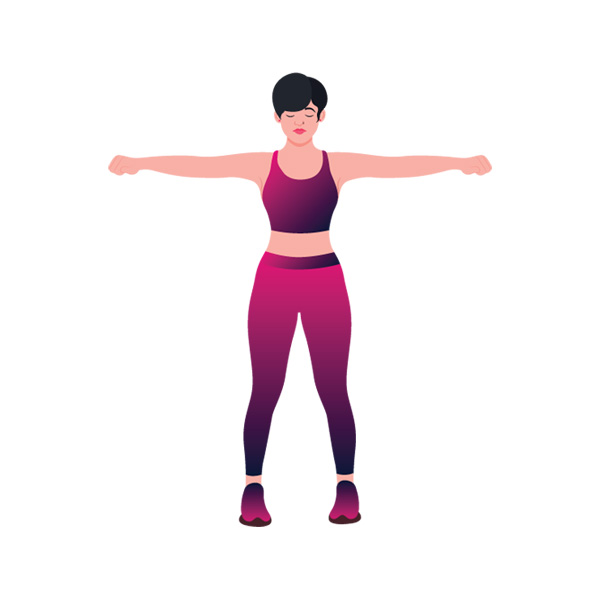
1. Arm Circles
What it is: Arm Circles are a simple yet effective warm-up exercise that involves rotating the arms in circular motions, both clockwise and counter-clockwise.
Benefits: This exercise increases blood flow and warms up the shoulder joints, preparing them for more intense activity. It also helps improve shoulder flexibility.
How To Do It: Stand with your feet shoulder-width apart. Extend your arms parallel to the floor and circle them slowly, starting with small circles, gradually getting larger. Do this for 30 seconds in each direction to warm up the shoulder joints.
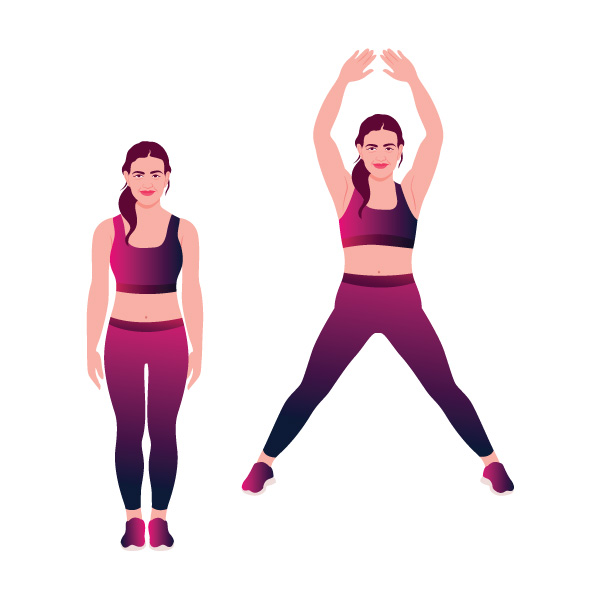
2. Jumping Jacks
What It Is: Jumping jacks are a classic cardio exercise that involves jumping with a movement that spreads the legs and arms out.
Benefits: This exercise elevates the heart rate and gets the entire body warmed up.
How To Do It: Start with your feet together and your hands by your sides. Jump up, spreading your feet beyond hip-width apart while simultaneously raising your arms above your head. Jump back to the starting position and repeat.
3. Jump Rope (Imaginary if no rope)
What It Is: Jump Rope is a more intense aerobic exercise where you hop over a swinging rope that passes under your feet and over your head with each jump. Alternatively, you can do this exercise with an imaginary rope if you don’t have one handy.
Benefits: Jump-roping enhances cardiovascular fitness, improves coordination, and tones the muscles of the lower body and arms. It’s also a high-calorie burner, making it excellent for weight loss.
How To Do It: Mimic the motion of jumping rope by hopping on the balls of your feet, swinging your arms as if you’re holding a rope. Do this for 1-2 minutes to build up a sweat.
4. Butt Kicks
What It Is: Butt kicks are a cardiovascular exercise that involves jogging in place while trying to kick your heels up to touch your buttocks.
Benefits: They serve as a dynamic warm-up to improve flexibility in the quadriceps and knees and increase heart rate, making them a good precursor to more intense exercises.
How To Do It: Stand with your feet hip-width apart and begin to jog in place, kicking your heels up towards your buttocks with each step. Pump your arms at the same time to maintain balance and increase the intensity of the workout.
Upper Body Exercises
Upper body exercises help build strength in the chest, back, shoulders, and arms. These are essential for a balanced physique and contribute significantly to overall functional strength. Incorporating these exercises can also improve your metabolism, aiding in more efficient fat burning and weight management.
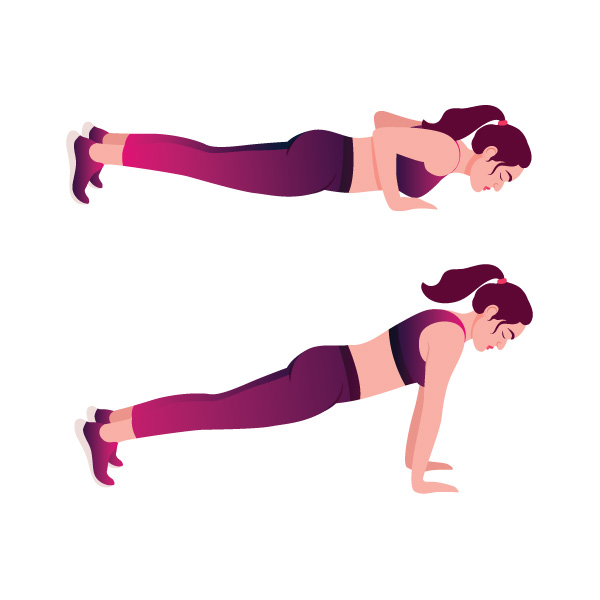
Push-Ups
What It Is: Push-ups are a fundamental body-weight exercise that involves raising and lowering the body using the arms while face down in a prone position.
Benefits: Push-ups target the chest, shoulders, triceps, and core, providing a balanced muscle build and enhancing upper body strength.
How To Do It: Start in a plank position with hands placed shoulder-width apart. Lower your body until your chest nearly touches the floor, then push yourself back up to the starting position.
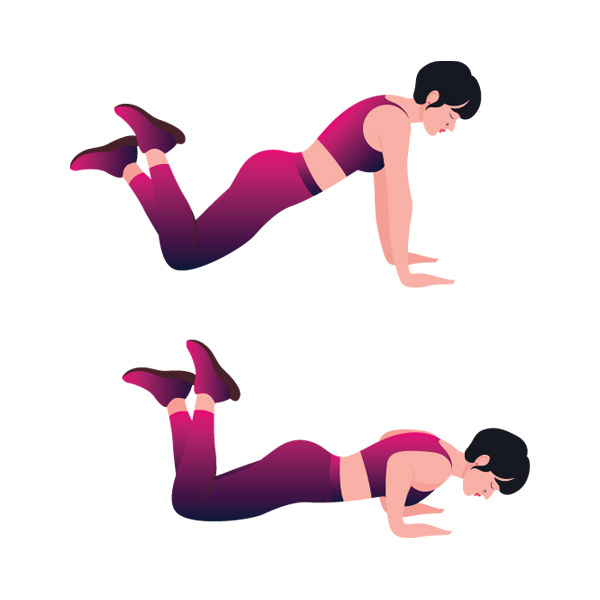
Push-Ups on the Knees (Modified Push-Ups)
What It Is: The push-up on the knees is simply a modified version of the classic push-up. By using the knees to touch the ground, instead of the toes, the push-up action is easier to perform.
Benefits: Push-ups help in building upper body strength and core stability. This exercise is a great starting point for beginners to build upper body strength.
How To Do It: Begin in a push-up position but let your knees touch the floor. Perform a push-up, maintaining a straight line from your shoulders to your knees.
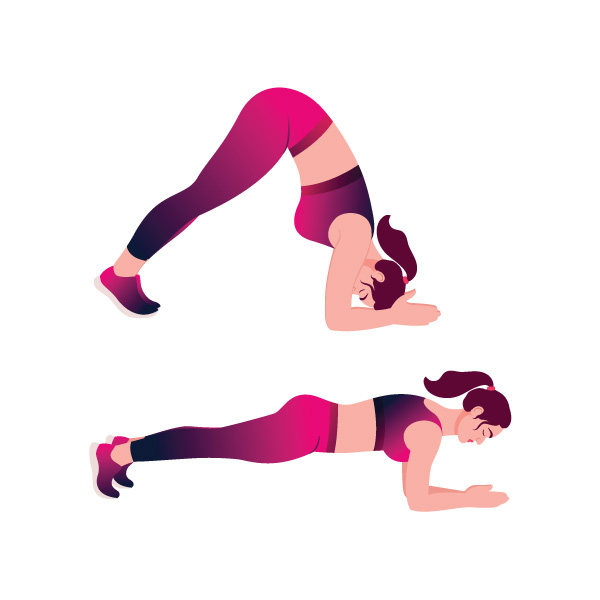
Dolphin Push-ups
What It Is: Dolphin push-ups are a variation of the traditional push-up that emphasizes the shoulders, arms, and core.
Benefits: This exercise strengthens the upper body, particularly the shoulders, arms, and core muscles, and can also help improve flexibility in the hamstrings and lower back.
How To Do It: Start in a forearm plank position with your elbows on the ground and your body in a straight line. Push your hips up towards the ceiling, diving your head down towards your toes, creating an inverted V shape with your body. Then, lower your hips back down to return to the starting plank position. Repeat the movement for several repetitions.
Pull-Ups (Using a sturdy bar)
What It Is: Pull-Ups are an upper body strength exercise where you lift your body up to a bar using a grip that is slightly wider than shoulder-width. This is also the only exercise on the list that may require a piece of equipment, depending on your situation.
Benefits: This powerful exercise strengthens the back, shoulders, and arms, and improves grip strength. It’s also effective for enhancing overall body composition.
How To Do It: Grip a pull-up bar with hands shoulder-width apart and palms facing away from you. Pull yourself up until your chin is level with the bar, then slowly lower back down. If you don’t have a bar, skip this exercise. (Be careful when choosing what to pull up on. Standard door frames are not made to mimic exercise equipment.)
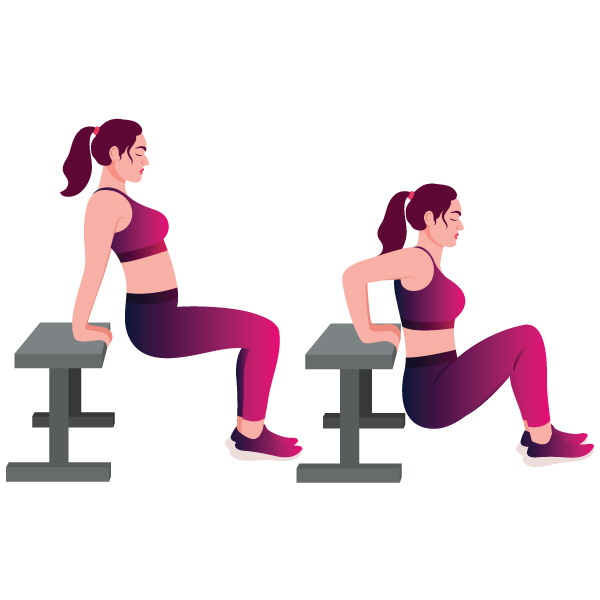
Tricep Dip (Chair Dip)
What It Is: Tricep dips target the triceps muscles and can be done using a stable surface like a chair or bench.
Benefits: This exercise strengthens the triceps, shoulders, and even engages the core.
How To Do It: Sit on the edge of a stable surface or chair, hands next to hips. Slide off the surface, supporting your weight with your arms. Bend your elbows to lower your body, then straighten to lift back up.
Lower Body Exercises
Lower body workouts are fundamental for building a strong base, enhancing mobility, and increasing muscle mass, which is vital for a higher resting metabolic rate. These exercises engage the largest muscles in your body, the quads, hamstrings, glutes, and calves, providing a solid foundation for overall fitness and accelerated weight loss.
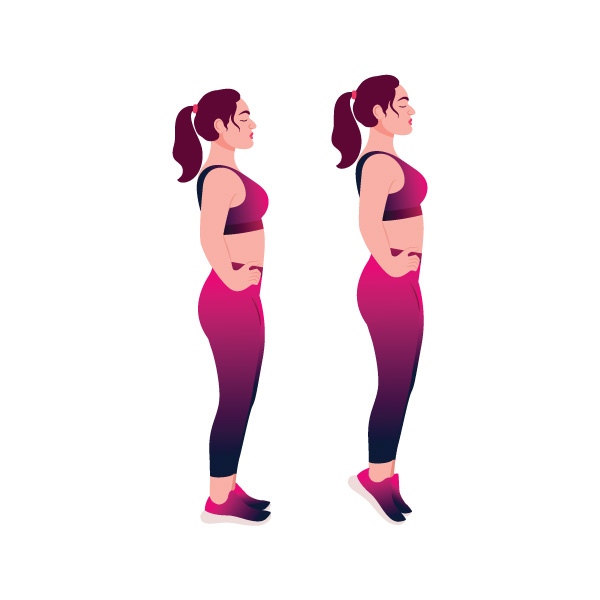
Calf Raises
What It Is: Calf Raises involve the lifting of the heels from a flat standing position to the balls of your feet, primarily targeting the calf muscles.
Benefits: This exercise strengthens the calves, improves ankle stability, and can enhance the muscular definition of the lower legs.
How To Do It: Stand up straight, then push through the balls of your feet and raise your heel until you are standing on your toes. Lower slowly back to the start.
Step-Up
What It Is: Step-Ups are performed by stepping onto an elevated platform with one foot and lifting your body up, followed by the other foot.
Benefits: They target the quadriceps, hamstrings, and gluteal muscles, and can improve balance and coordination.
How To Do It: Find a step or a sturdy platform. Step up with one foot, pressing through the heel to lift your other leg up to the step. Step back down and repeat, then switch legs.
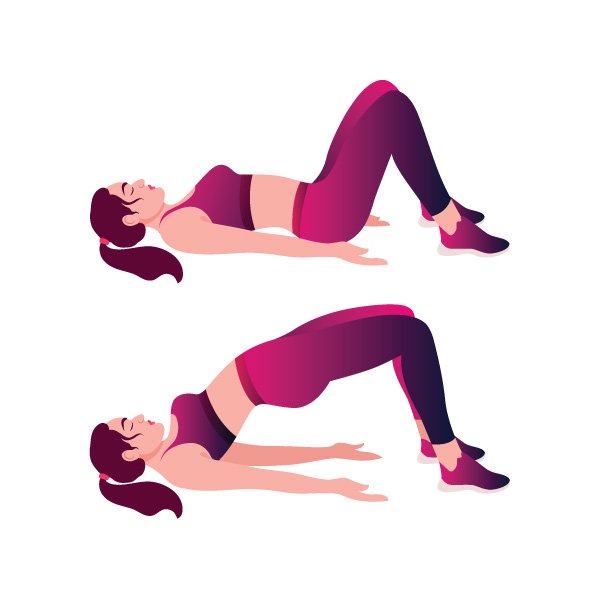
Glute Bridge
What It Is: Glute Bridges involve lying on your back with knees bent and lifting the hips towards the ceiling, engaging the glutes and hamstrings.
Benefits: They target the glutes, strengthen the core, and can help in reducing lower back pain.
How To Do It: Lie on your back with your knees bent and feet flat on the ground. Lift your hips off the ground until your knees, hips, and shoulders form a straight line. Squeeze your glutes hard and keep your abs drawn in so you don’t overextend your back during the exercise.
Superman
What It Is: The Superman exercise involves lying face down and simultaneously lifting the arms and legs off the ground, resembling the flying superhero.
Benefits: It’s excellent for strengthening the lower back, glutes, and hamstrings, and can help alleviate back pain by reinforcing the entire posterior chain.
How To Do It: Lie face down on the ground with your arms extended in front of you. Raise your hands and feet off the ground as high as you can, creating a slight curve in your body.
Wall Sit
What It Is: The wall sit is a static exercise that involves maintaining a seated position against a wall for a set period of time. It’s like sitting in a chair, but without the chair.
Benefits: Wall sits build endurance and strength in the lower body, targeting the quadriceps, hamstrings, calves, and glutes. They also engage the core muscles, which helps to improve postural support and stability. Regularly performing wall sits can increase lower body muscular endurance, making it easier to perform daily activities like climbing stairs or squatting to pick something up.
How To Do It: Start by standing about two feet in front of a wall with your back facing the wall. Lean back and slide down the wall until your thighs are parallel to the ground. Make sure your knees are directly above your ankles and bent at a 90-degree angle. Keep your back flat against the wall. Place your hands on your thighs or by your sides to avoid putting stress on your knees. Hold this position for 20-60 seconds, or as long as you can maintain proper form. Stand up slowly, using your hands on your thighs to support you if needed.
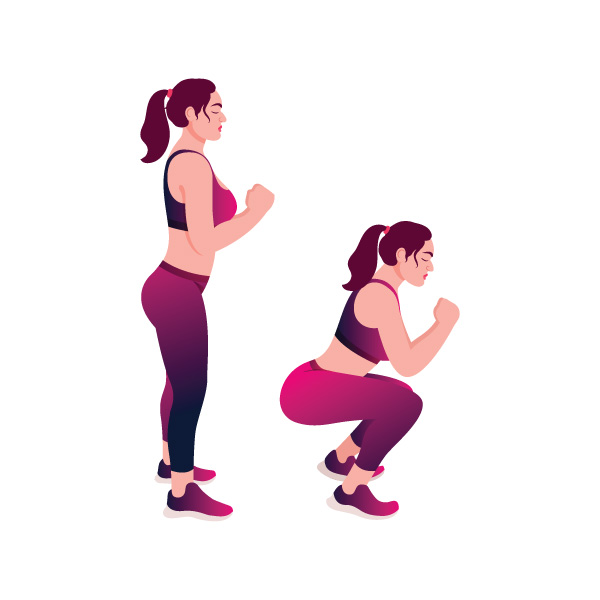
Squat
What It Is: Squats primarily target the thighs, hips, and buttocks.
Benefits: Squats engage and strengthen the quads, hamstrings, glutes, and core. They also improve flexibility in the lower back and hips, and they can help with balance.
How To Do It: Stand with feet hip-width apart. Bend your knees and lower your body as though you are sitting in a chair. Keep your back straight and return to the standing position.
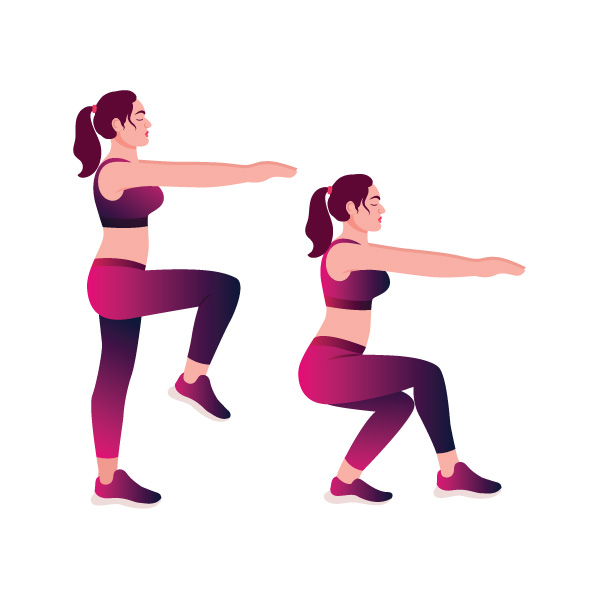
Single Leg Drop Squat
What It Is: A Single Leg Drop Squat involves balancing on one leg, squatting down while the other leg is extended out, and then standing back up.
Benefits: It’s beneficial for improving balance, unilateral strength, and engaging core stability.
How To Do It: Stand with your feet together. Lift one foot off the ground and extend it forward. Lower into a squat position on the standing leg without letting the lifted foot touch the ground. Return to the starting position.
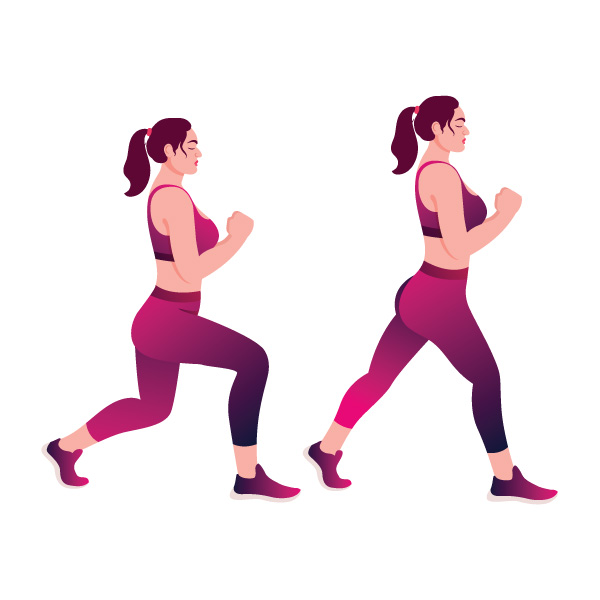
Squat Walk
What It Is: Squat Walks involve staying in a squat position and walking forward or sideways, maintaining the squat depth throughout the movement.
Benefits: This exercise enhances leg strength, especially in the quads and glutes, and increases muscular endurance and stability.
How To Do It: Remain in a squat position and take a step to the side, maintaining the squat depth. Step the other foot to meet the first foot. Continue side-stepping in this squat position.
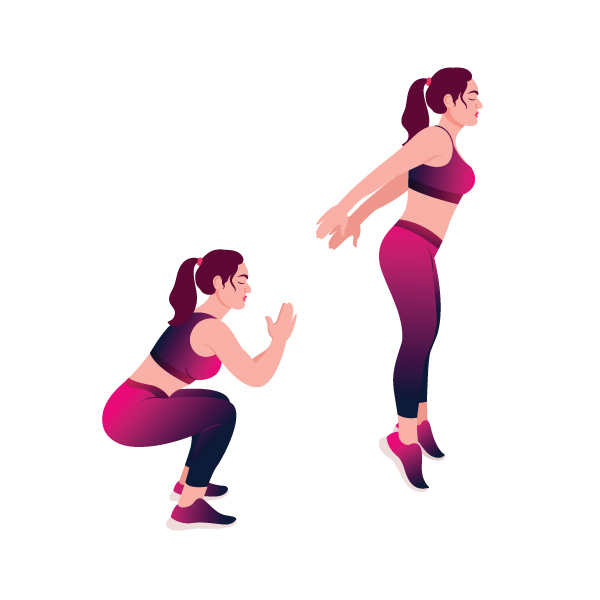
Squat Jump
What It Is: Squat Jumps start from a squat position and involve an explosive jump upwards, returning to a squat upon landing.
Benefits: This plyometric exercise increases power, burns high amounts of calories, and strengthens the entire lower body.
How To Do It: Perform a regular squat, then engage your core and jump up explosively. When you land, lower your body back into the squat position to complete one rep.
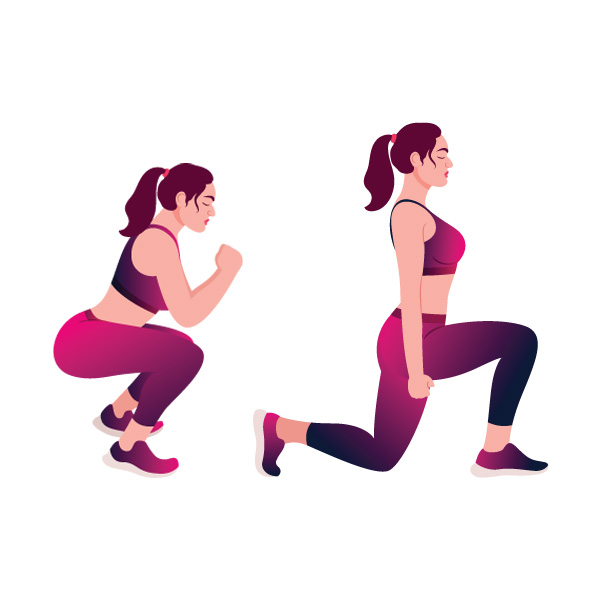
Squat to Lunge
What It Is: Squat to Lunge is a dynamic movement that combines a traditional squat with a forward or backward lunge.
Benefits: It increases lower body strength and flexibility, enhances coordination, and engages the core muscles for added stability.
How To Do It: Start in a squat position, then step back into a lunge, and return to the squat position. Repeat on the other side.

Lunges
What It Is: Lunges are a unilateral exercise that primarily targets the legs, including the quadriceps, hamstrings, glutes, and calves.
Benefits: Lunges enhance leg and glute strength, balance, and flexibility. They also engage core muscles for stability.
How To Do It: Stand with feet hip-width apart. Step forward with one leg and lower your body until both knees are bent at about a 90-degree angle. Push back up to the starting position and repeat with the other leg. Make sure your front knee is directly above your ankle, not pushed out too far. Keep the weight in your heels as you push back up to the starting position.
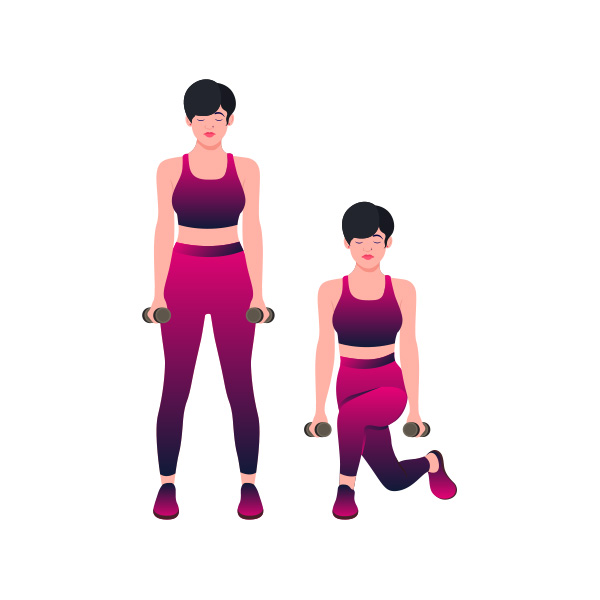
Curtsy Lunge
What It Is: A Curtsy Lunge involves stepping one leg behind the other at an angle and bending both knees to lower into a lunge.
Benefits: This exercise targets the glute medius and inner thighs, helps improve hip stability, and provides a good stretch for the hip flexors.
How To Do It: Stand straight with feet hip-width apart. Move your left leg behind you and to the right so that your thighs cross, bending both knees as if you were curtsying.
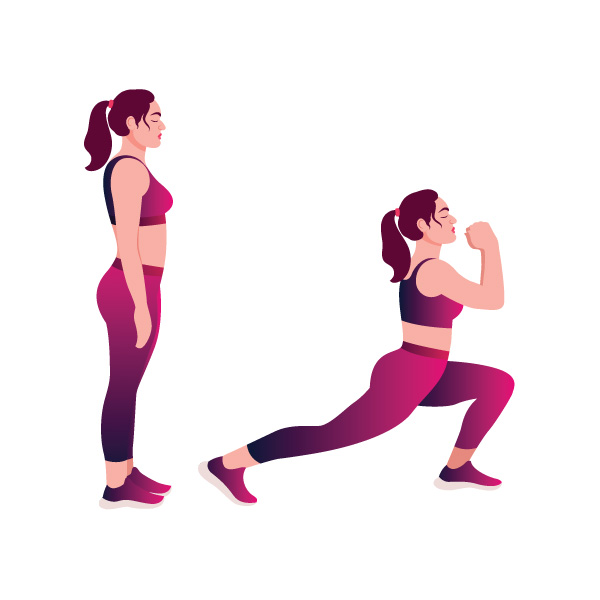
Walking Lunge
What It Is: Walking Lunges involve stepping forward into a lunge and then bringing the rear leg forward into a continuous walking motion.
Benefits: They improve dynamic balance, increase hip flexibility, and build strength in the legs and glutes.
How To Do It: Perform a lunge, then bring the rear leg forward to step into a lunge on the other side, moving forward.
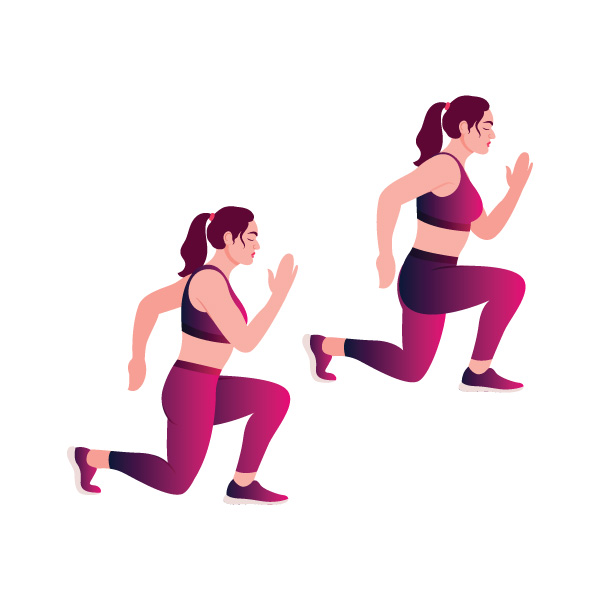
Split Lunge Jump
What It Is: Split Lunge Jumps start in a lunge position and involve jumping up to switch the front and back legs in mid-air, landing back in a lunge.
Benefits: This high-intensity move increases heart rate, builds lower body strength, and adds a plyometric challenge to improve explosive power.
How To Do It: Start in a lunge position. Jump up and switch your legs in midair, landing in a lunge with the opposite leg forward.
Core Exercises
Core exercises are the cornerstone of a good fitness regimen, especially when the goal is weight loss. These exercises target the muscles around your midsection, including the abdominals, lower back, and obliques. A strong core improves posture, stability, and overall strength, making everyday movements easier and more efficient.
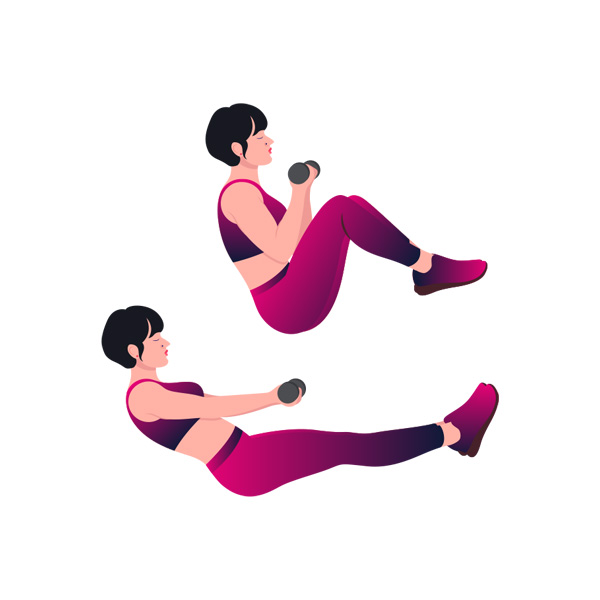
Sit-Ups
What It Is: Sit-ups are a traditional core exercise that involves lifting your upper body off the ground towards your knees while lying on your back.
Benefits: Sit-ups target multiple muscle groups including the abs, hip flexors, and the muscles of the lower back. This compound movement helps improve core strength and stability.
How To Do It: Lie on your back, bend your knees, and plant your feet firmly on the ground. Cross your hands to opposite shoulders or place them behind your ears. Curl your upper body all the way up toward your knees, then slowly lower yourself back down.

Crunches
What It Is: Crunches are a focused abdominal exercise, performed by lifting your shoulders off the ground and engaging the core while lying on your back.
Benefits: Crunches primarily work the rectus abdominis and obliques, aiding in the development of a strong core. This can contribute to better posture.
How To Do It: Lie down on your back with knees bent and feet flat on the ground. Place your hands behind your head. Lift your upper back off the ground, engaging your core, then gently lower back down.
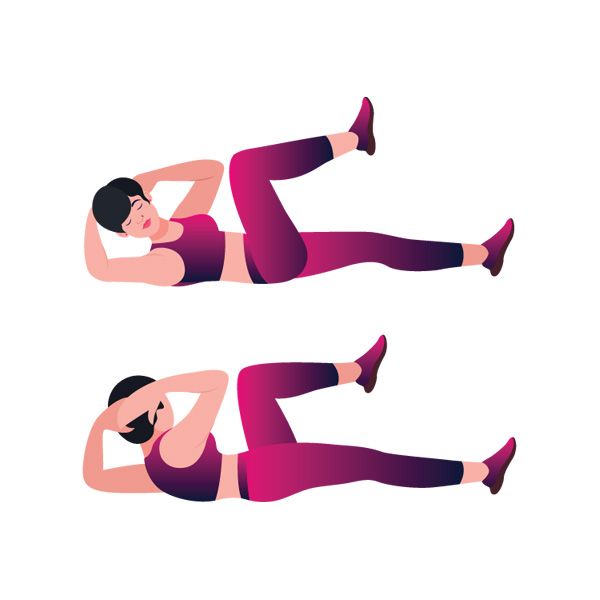
Bicycle Crunches
What It Is: Bicycle crunches are an effective abdominal exercise that engages both the rectus abdominis and the obliques.
Benefits: This exercise works both the upper and lower abs and obliques to help build core strength and stability.
How To Do It: Lie on your back with hands behind your head, elbows wide. Lift your shoulders off the ground and bring one knee towards your chest while extending the other leg. Twist your body to bring the opposite elbow to the knee. Alternate sides in a pedaling motion.
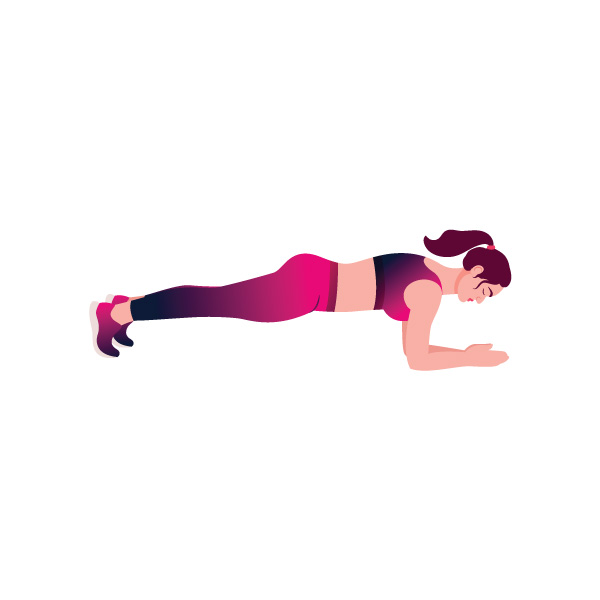
Plank
What It Is: The plank is an isometric core strength exercise that involves maintaining a position similar to a push-up for a set amount of time.
Benefits: It strengthens the core, improves posture, and can help reduce back pain.
How To Do It: Lie face down with forearms on the floor and elbows aligned below the shoulders. Push up onto your forearms, keeping your body in a straight line from head to heels. Hold this position for as long as you can.
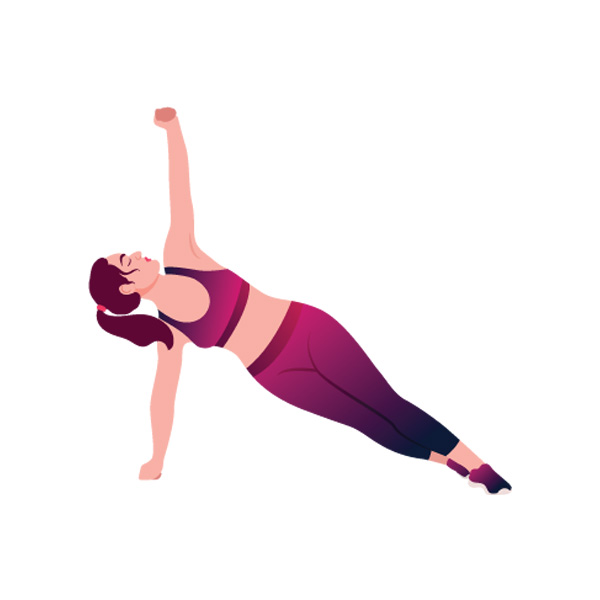
Side Plank
What It Is: The side plank is a variation of the traditional plank that focuses more on the obliques.
Benefits: Side planks strengthen the oblique muscles, improve balance, and enhance core stability.
How To Do It: Lie on your side with legs extended and one elbow under your shoulder. Lift your hips off the ground, forming a straight line from head to feet. Hold this position, then switch to the other side.
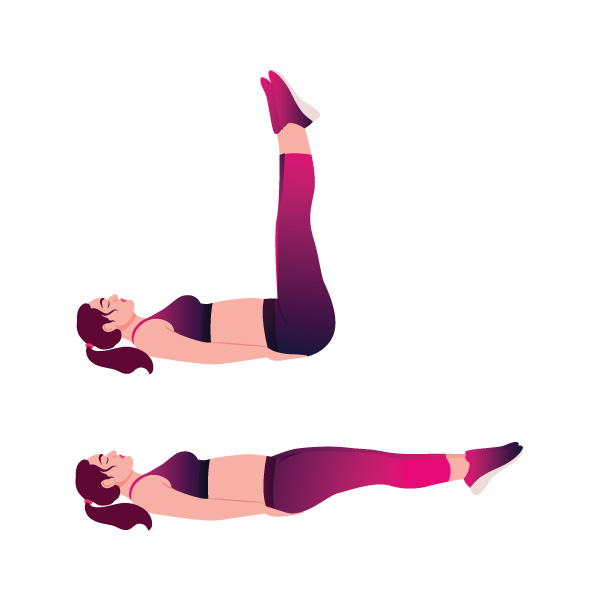
Abdominal Leg Lift
What It Is: The abdominal leg lift is a core-strengthening exercise that targets the lower abdominals.
Benefits: This exercise helps in toning the lower abdominal muscles and can aid in reducing lower belly fat. It also improves stability and strength in the core which is essential for good posture and overall fitness.
How To Do It: Lie on your back with your legs straight and hands beneath your hips for support. Slowly raise your legs straight up towards the ceiling, keeping them as straight as possible, then lower them back down without letting them touch the floor. Repeat for several repetitions.
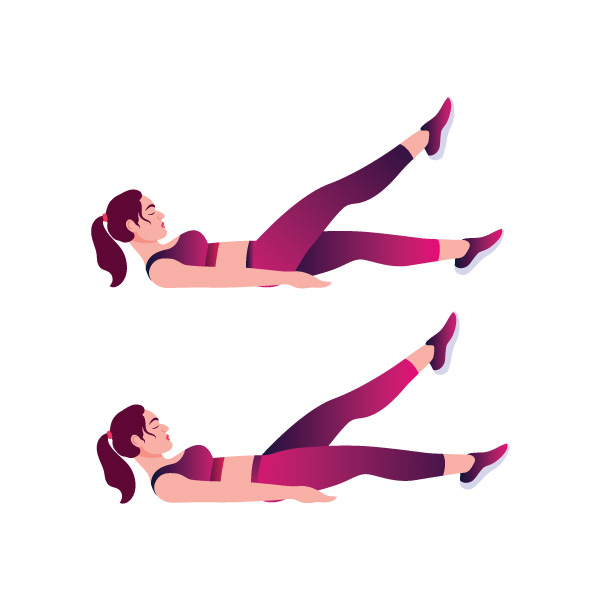
Flutter Kick
What It Is: Flutter kicks are a simple but effective lower abdominal exercise performed lying on your back.
Benefits: They target the lower abs and hip flexors, and can also help improve lower back strength and stability. It’s a great exercise for improving endurance and core strength.
How To Do It: Lie on your back with your legs extended and hands underneath your buttocks to support your lower back. Lift your heels a few inches off the ground and begin kicking your legs up and down in a small, rapid motion. Keep your core engaged and avoid letting your lower back arch off the ground.
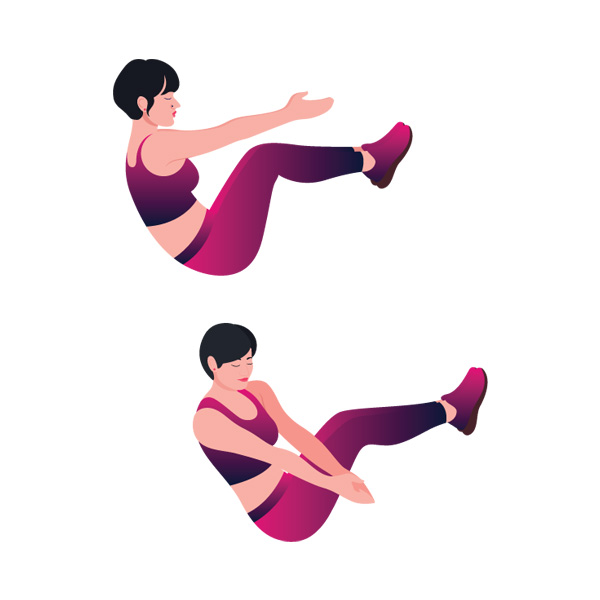
Russian Twist
What It Is: The Russian twist is a core exercise that involves twisting your torso from side to side while seated.
Benefits: This movement engages all of the abdominal muscles, with an emphasis on the obliques, aiding in the development of a strong, toned core and improved balance.
How To Do It: Sit on the floor with your knees bent and feet flat. Lean back slightly to create a V shape with your thighs and torso. Clasp your hands together in front of you and twist your torso to the right, then to the left, to complete one rep. For more intensity, lift your feet off the floor during the exercise.
Full Body Exercises
Full body exercises are incredibly efficient for those looking to lose weight and improve overall fitness. They engage multiple muscle groups at once, leading to higher calorie burns and a more dynamic workout. These movements can also simulate daily physical activities, improving both muscular and cardiovascular endurance.
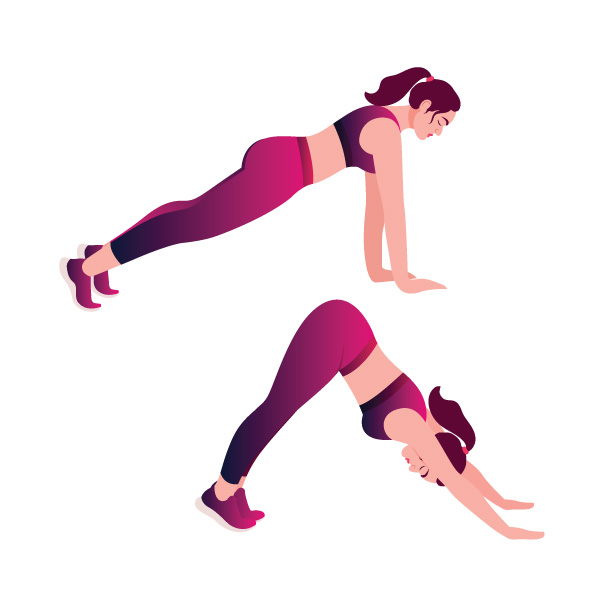
Inchworm
What It Is: The inchworm is a full-body exercise that involves walking your hands on the floor to stretch and strengthen various muscle groups.
Benefits: Inchworms work the arms, chest, upper and lower back, abs, and legs. This exercise also enhances flexibility in the hamstrings and calves and can serve as a dynamic warm-up or cool-down.
How To Do It: Stand with your feet hip-width apart. Bend at the waist and touch the floor with your palms. Walk your hands forward until you reach a plank position. Hold for a moment, then walk your feet towards your hands, keeping your legs as straight as possible. Stand up and repeat the sequence.
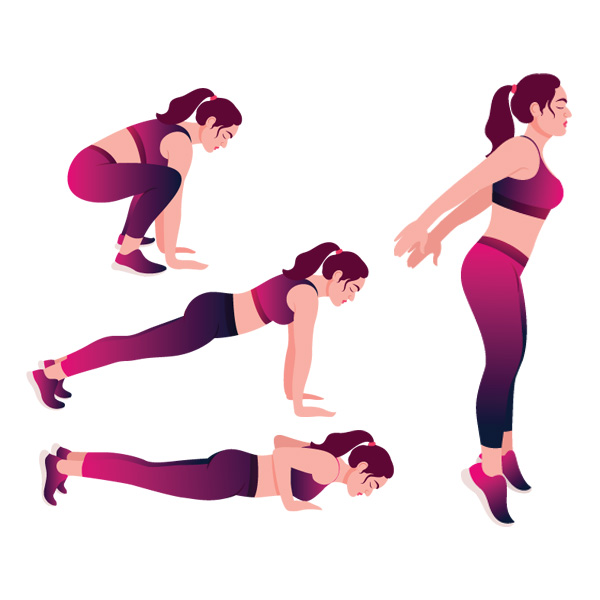
Burpee
What It Is: Burpees are a high-intensity full-body exercise that combines a squat, plank, and jump.
Benefits: Burpees are great for burning a lot of calories in a short time. They improve strength and cardiovascular fitness, working almost every muscle in your body.
How To Do It: Start in a standing position. Move into a squat position with your hands on the ground. Kick your feet back into a plank position, then immediately return your feet to the squat position. Explosively jump up from the squat position.
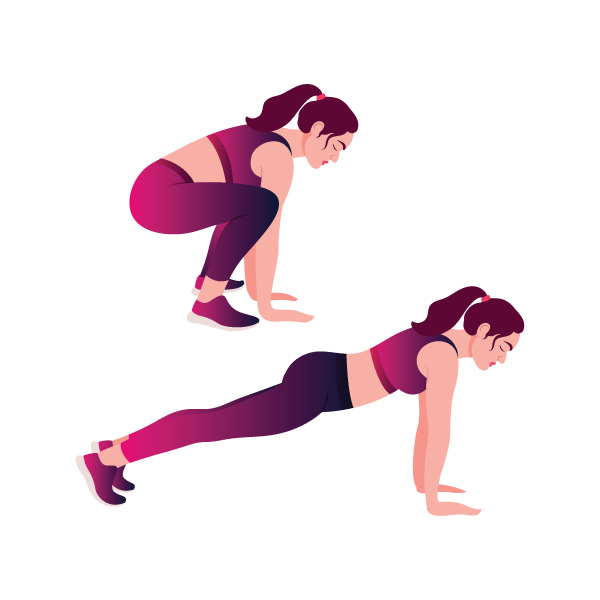
Frogger
What It Is: Froggers are performed by starting in a plank position, jumping the feet forward to where the hands are, and then jumping back into a plank.
Benefits: They increase cardiovascular endurance, improve lower body strength, and add a fun, dynamic component to any workout.
How To Do It: Start in a plank position. Jump your feet outside of your hands, landing in a deep squat with your hands still on the floor. Jump back to the plank position.
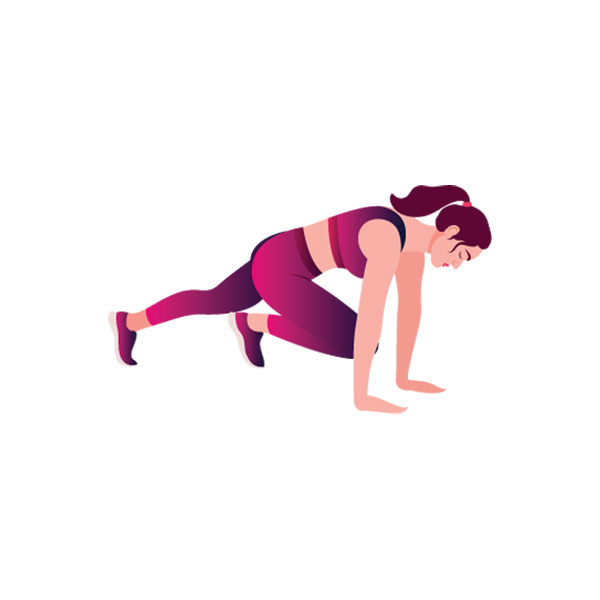
Bear Crawl
What It Is: Bear Crawls are done on all fours with the knees just off the ground, moving forward or backward using opposite limbs.
Benefits: This full-body exercise improves strength and coordination, targets the core, and can improve cardiovascular conditioning.
How To Do It: Get on all fours with your knees slightly above the ground. Move forward using your right hand and left foot, then your left hand and right foot, alternating in a crawling motion.
Cardio Exercises
Cardiovascular exercises are vital for heart health and burning calories. These high-energy movements increase your heart rate, boost metabolism, and can be an effective way to create a calorie deficit for weight loss. Incorporating a variety of cardio exercises keeps the routine engaging and targets different muscle groups.
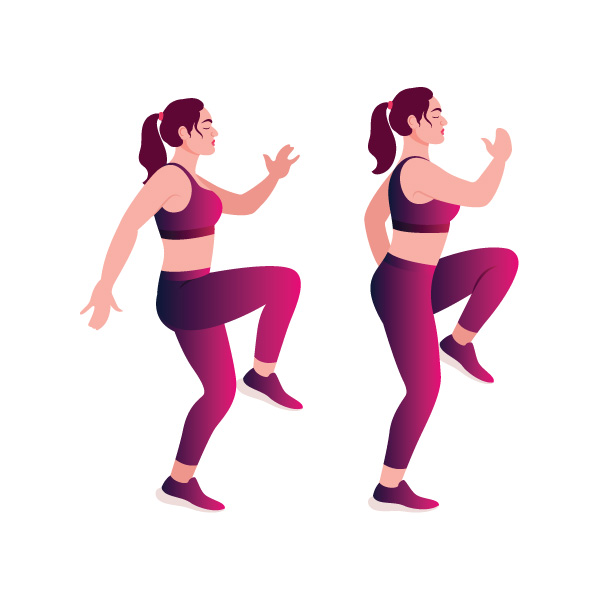
High Knees
What It Is: High knees are a cardio-intensive exercise that involves running in place while lifting your knees as high as possible.
Benefits: The high knees exercise provides a high-intensity cardio workout that improves coordination, flexibility, and endurance. It also engages your core and strengthens your leg muscles.
How To Do It: Stand with feet hip-width apart. Quickly drive your knees up towards your chest, one at a time, while maintaining an upright posture.
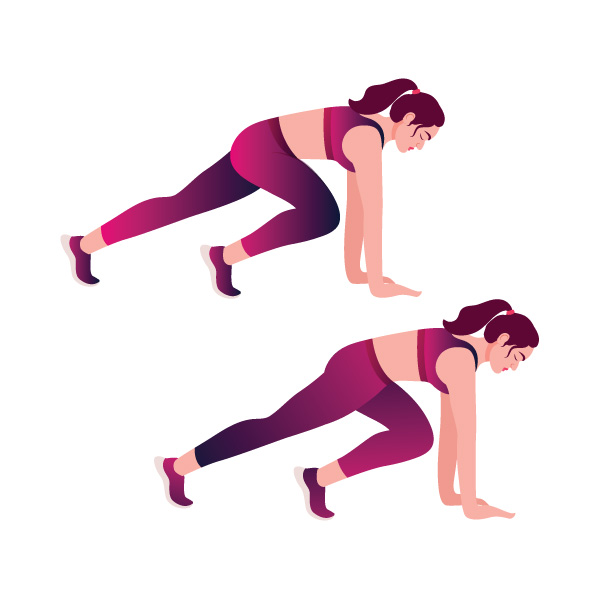
Mountain Climber
What It Is: Mountain climbers are a compound exercise that combines cardiovascular and strength training.
Benefits: This exercise increases heart rate, burns calories, and strengthens the core, arms, and legs.
How To Do It: Start in a plank position. Bring one knee towards your chest, then quickly switch to the other leg, as if you are running in place in a plank position.
Shadow Boxing
What It Is: Shadow boxing is a workout that involves punching the air as if sparring with an imaginary opponent.
Benefits: This exercise provides both aerobic and anaerobic benefits, improves hand-eye coordination, and increases upper body strength and agility. It also serves as a good way to relieve stress.
How To Do It: Stand with your feet shoulder-width apart and knees slightly bent. Punch with controlled movements, rotating your torso and extending your arms fully, while keeping your fists clenched and returning them to your chin after each punch. Move around as you punch to engage different muscle groups and make the exercise more dynamic.
Dance
What It Is: Dance is a rhythmic and expressive form of movement to music that can vary in intensity and style.
Benefits: It’s an enjoyable way to burn calories, improve cardiovascular health, and increase endurance. Plus, it’s a fantastic way to boost your mood and relieve stress.
How To Do It: Put on your favorite music and let loose. Dance for at least 20-30 minutes. It’s a fun way to burn calories while improving cardiovascular health.
Flexibility and Balance
Flexibility and balance exercises are often overlooked, but they play a significant role in a well-rounded fitness routine. These exercises improve muscle elasticity, joint mobility, and can reduce the risk of injuries. They also enhance body control, which is beneficial for maintaining proper form during other exercises and in daily activities.
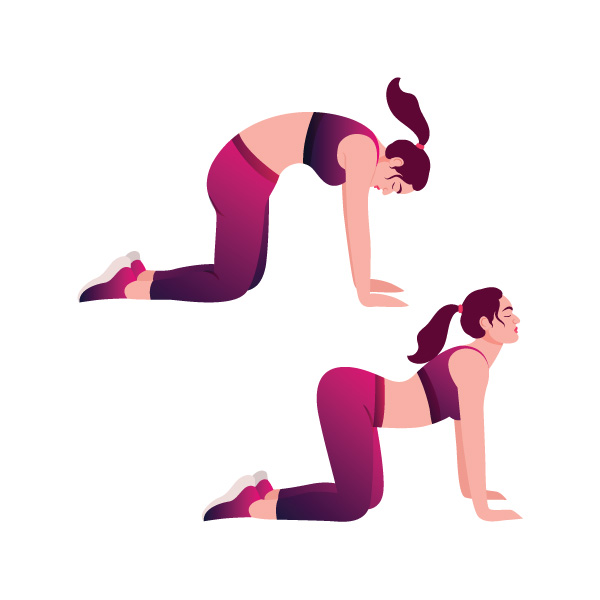
Yoga
What It Is: Yoga is a series of stretches and poses done with attention to breathing and mindfulness.
Benefits: It enhances flexibility, reduces stress, and can lead to better body awareness, aiding in weight management and overall well-being.
How To Do It: Choose a sequence of poses and hold each one for a set number of breaths.
Creating Your Own Exercise Routine
We’ve covered a lot of exercises in this guide. But, as a beginner, where do you start?
If you’re new to structured exercise (or getting back into it), the key to success is building a sustainable exercise routine that you can stick to. Here’s how you can create an effective workout plan that suits your objectives and your physical abilities:
Start with a Goal
Define what you want to achieve. Is it simply to lose weight, develop muscle tone, or improve your overall fitness level? Having a clear goal will keep you motivated and help you tailor your workout to meet your objectives.
Assess Your Fitness Level
Be honest about your current fitness level. You don’t want to set yourself up for injury or burnout by doing too much, too soon.
Keep it Balanced
A well-rounded routine includes a variety of exercises. Start with warm-up exercises, then include a mix of upper body, lower body, core, and full body activities. Be sure to incorporate cardio as well, whether you choose an indoor exercise listed above or you head outside for a walk or hike. Then cool down some stretching or yoga to improve range of motion and reduce the risk of injuries.
Plan Your Weekly Schedule
Begin with shorter, less frequent workouts, aiming for 20-30 minutes, 3 times a week. Gradually increase the duration and frequency as your stamina and strength improve.
Structure Your Workout
Start with a 5-10 minute warm-up. Follow with 15-20 minutes of a mix of cardio and strength exercises, focusing on different muscle groups. Finish with 5-10 minutes of cool-down activities, like stretching or practicing balance exercises.
Vary the Intensity
Incorporate both low and high-intensity workouts into your routine to keep challenging your body. This approach, known as interval training, can be highly effective for weight loss.
Track Your Progress
Make a note of your workouts, including what you did, how you felt, and any progress you’ve noticed. This log will provide insight into what’s working and what’s not, allowing you to make necessary adjustments.
Listen to Your Body
Don’t overdo it. If you’re feeling pain (not just the usual workout discomfort), take a break. And just like you plan your workout days, plan your rest days. Your body needs them for recovery.
Stay Consistent
Consistency is more important than intensity when starting out. It’s better to do shorter workouts regularly than to push too hard and skip sessions.
Seek Guidance
Don’t hesitate to look for online workouts or fitness apps that offer beginner routines. They can provide structure and ensure you’re doing exercises correctly.
Final Thoughts
Being stuck inside doesn’t have to keep you from your health and weight loss goals. As you’ve seen in this guide, there are numerous ways to stay active when you’re cooped up in the house. Just remember, consistency is key, and pairing these workouts with a balanced diet will yield the best outcomes.
Stay hydrated, listen to your body, and be patient with your weight loss journey!
You got this!
